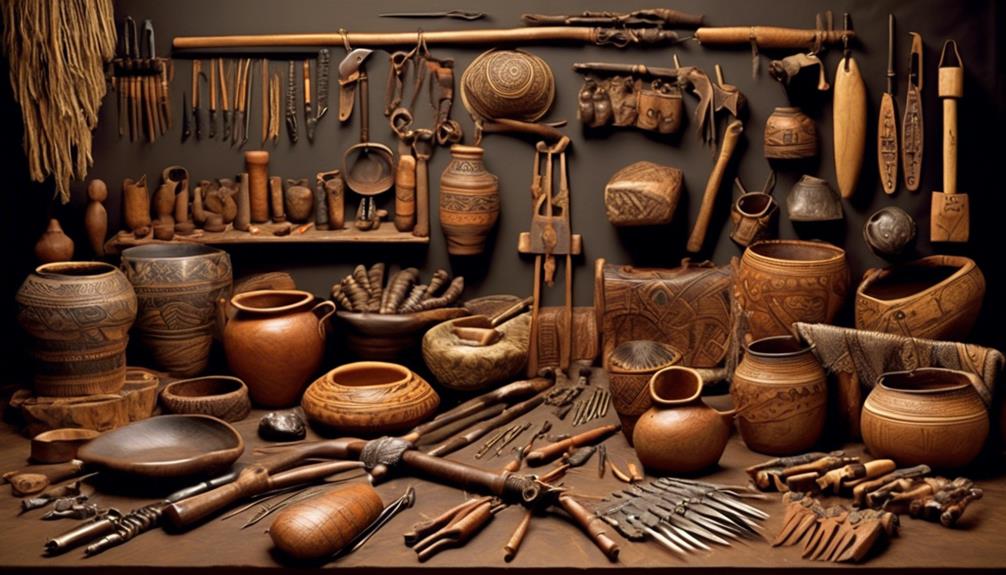When analyzing the impacts of the Columbian Exchange, the focus is frequently on the negative consequences such as the spread of diseases and the exploitation of indigenous peoples. However, it is important to acknowledge the positive goods that Europeans introduced for trading with native communities during this time.
The exchange of goods between the two groups had a profound effect on both European and indigenous societies, shaping the course of history in unforeseen ways. As we explore the types of goods that were traded during this period, we begin to unravel a complex web of interactions that transformed the world as we know it.
Key Takeaways
- European trade networks brought metal tools, weaponry, textiles, and pottery to the Americas.
- The exchange of goods introduced advanced technologies to indigenous communities, transforming their methods of production.
- The trade of luxury items and precious metals reshaped global trade routes and fueled the growth of mercantile capitalism in Europe.
- Indigenous societies adopted European clothing and technologies, leading to cultural assimilation and lasting impacts on their social and economic dynamics.
Introduction to the Columbian Exchange
We'll explore the profound impact of the Columbian Exchange, a pivotal event in global history, which facilitated the exchange of goods, ideas, and diseases between the Eastern and Western Hemispheres.
The Columbian Exchange had a significant impact on the global economy, leading to the widespread exchange of goods that transformed trade and commerce on a global scale. The introduction of new crops, such as potatoes and maize to Europe, and wheat and sugar to the Americas, changed dietary habits and agricultural practices, leading to population growth and urbanization. This exchange also led to the transfer of livestock, which significantly altered the methods of food production in both hemispheres.
Furthermore, the exchange of diseases had a profound impact on the indigenous populations of the Americas. The introduction of diseases such as smallpox, measles, and influenza, for which the indigenous peoples had no immunity, led to devastating epidemics and a significant decline in population. This demographic catastrophe altered the social and economic fabric of the Americas, impacting labor systems and trade networks.
Agricultural Products and Livestock

The exchange of agricultural products and livestock in the Columbian Exchange not only transformed dietary habits and food production methods but also had a profound impact on the demographic and economic landscape of both the Eastern and Western Hemispheres.
The introduction of new crops such as wheat, rice, and coffee from Europe to the Americas, and maize, potatoes, and tomatoes from the Americas to Europe, significantly increased crop diversity in both regions. This transfer of agricultural products revolutionized diets, leading to more varied and nutritious meals.
Moreover, the Columbian Exchange facilitated the exchange of agricultural techniques and practices. European settlers introduced advanced farming methods to the Americas, including crop rotation and the use of iron tools, which significantly improved agricultural productivity. Conversely, indigenous agricultural knowledge such as terracing and irrigation techniques influenced European farming practices, contributing to the development of more sustainable agricultural systems.
In addition to crops, the exchange of livestock greatly impacted both hemispheres. Europeans introduced domesticated animals such as horses, cattle, and pigs to the Americas, transforming animal husbandry practices. Simultaneously, the transfer of turkeys, llamas, and alpacas from the Americas to Europe enriched European livestock breeding programs, contributing to the diversity of livestock in both regions.
Manufactured Goods and Tools

During the Columbian Exchange, the transfer of manufactured goods and tools between Europe and the Americas significantly impacted the technological and economic landscapes of both regions. European trade networks facilitated the exchange of a wide array of manufactured goods and tools, introducing advanced technologies to the indigenous peoples of the Americas.
Items such as metal tools, weaponry, textiles, and pottery were brought from Europe to the Americas, while products like maize, potatoes, and cacao made their way to Europe. This cultural exchange led to the adoption of new tools and technologies by indigenous communities, transforming their methods of production and daily lives.
The introduction of European-manufactured goods also contributed to the development of new trade networks and economic systems in the Americas. The exchange of goods between the two regions not only shaped their material cultures but also had lasting effects on their social structures and economic interactions.
The Columbian Exchange thus stands as a pivotal moment in history, marking a significant shift in the global exchange of goods, technologies, and ideas.
Luxury Items and Precious Metals

In the exchange between Europe and the Americas, luxury items such as silk, spices, and precious metals played a significant role in shaping the economic and cultural dynamics of both regions. The trade dynamics of luxury items and precious metals between Europe and the Americas were intricate and multifaceted, impacting the economic implications of both regions.
- Trade Dynamics
- The introduction of luxury items like silk and spices from Asia to Europe, and subsequently to the Americas, reshaped the global trade routes, leading to the rise of new economic powers and the decline of traditional trading hubs.
- The influx of precious metals from the Americas to Europe had a profound impact on the economic stability of various European nations, leading to inflation, increased trade, and the growth of mercantilism.
- Economic Implications
- The availability of luxury items and precious metals in Europe fueled the growth of mercantile capitalism, leading to the establishment of powerful trading companies and the expansion of global trade networks.
- In the Americas, the trade of luxury items and precious metals led to the exploitation of indigenous populations, the establishment of colonial economies, and the disruption of traditional trade systems.
The exchange of luxury items and precious metals during the Columbian Exchange significantly altered the economic and cultural landscapes of both Europe and the Americas.
Impact on Indigenous Societies
As we consider the impact on indigenous societies, the exchange of luxury items and precious metals not only reshaped economic and cultural dynamics but also brought about significant disruptions to traditional trade systems and the exploitation of native populations. The influx of European goods led to trade imbalances, where indigenous societies often traded valuable resources for items of little practical use, leading to economic instability. Additionally, the introduction of European goods and the shift towards a European market-oriented economy contributed to environmental degradation as traditional subsistence practices were abandoned in favor of cash crops and resource extraction.
| Impact on Indigenous Societies |
|---|
| Cultural Assimilation |
| Trade Imbalances |
| Environmental Degradation |
| Disease Transmission |
| Exploitation of Native Populations |
Moreover, the Columbian Exchange resulted in the spread of diseases such as smallpox and measles, which devastated indigenous populations that had no immunity to these illnesses. The introduction of European goods also led to cultural assimilation, as indigenous societies began to adopt European clothing, tools, and technologies, leading to the erosion of traditional cultural practices and knowledge. The impact of the exchange on indigenous societies was profound and continues to shape the social and economic dynamics of many indigenous communities today.
Frequently Asked Questions
How Did the Columbian Exchange Impact the Spread of Diseases Among Indigenous Peoples?
The impact of diseases during the Columbian Exchange was profound. The spread of new illnesses devastated indigenous populations, but their resilience and ingenuity also played a crucial role.
The exchange led to the introduction of new pathogens, causing widespread mortality and societal upheaval among indigenous peoples. This historical event reshaped the demographic landscape of the Americas and had lasting effects on the development of societies in the region.
Were There Any Negative Effects of the Trade of Agricultural Products and Livestock on Indigenous Societies?
In the trade of agricultural products and livestock with indigenous societies, negative effects were felt both culturally and economically.
The introduction of new crops and animals disrupted traditional practices and led to the loss of indigenous knowledge and biodiversity.
Additionally, the shift in food production and consumption patterns had lasting impacts on indigenous societies.
These changes contributed to social upheaval and the erosion of traditional cultural practices, displaying the complex consequences of the Columbian Exchange.
What Role Did Indigenous Peoples Play in the Production and Trade of Manufactured Goods and Tools During the Columbian Exchange?
In the production and trade of manufactured goods and tools during the Columbian Exchange, indigenous peoples played a crucial role. Their expertise and cultural practices had a significant impact on traditions and trade roles.
They contributed unique goods and skills, enriching the exchange and shaping the development of trade networks.
This dynamic interaction influenced the evolution of trade practices and the spread of valuable resources, creating a lasting impact on both indigenous and European societies.
Were Luxury Items and Precious Metals Considered Valuable by Indigenous Peoples, or Were They More Interested in Other Goods Offered by Europeans?
Luxury items and precious metals were indeed valuable to indigenous peoples during the Columbian Exchange. However, they were also interested in other goods offered by Europeans.
Indigenous preferences and trade dynamics played a crucial role in shaping the cultural exchange. This intercultural interaction led to the exchange of various goods, from textiles and tools to food and animals.
The Columbian Exchange was a complex interplay of desires and needs, shaping the trade dynamics between indigenous peoples and Europeans.
How Did the Introduction of European Goods and Products Impact the Cultural Practices and Traditions of Indigenous Societies?
The introduction of European goods and products had a profound impact on the cultural practices and traditions of indigenous societies.
The influx of new goods led to a shift in traditions and cultural assimilation as indigenous peoples incorporated European items into their daily lives.
This transformation brought both challenges and opportunities, shaping a new cultural landscape that reflected the fusion of old and new ways of life.
Conclusion
In conclusion, the Columbian Exchange brought about a significant exchange of goods between Europeans and indigenous peoples. While it introduced new agricultural products, livestock, manufactured goods, luxury items, and precious metals to indigenous societies, it also had a lasting impact on their traditional way of life.
The exchange of goods, although beneficial in some aspects, resulted in a complex and often tumultuous relationship between the two groups, ultimately shaping the course of history.
Mary is a passionate writer who brings creativity and a fresh perspective to our team. Her words have the power to captivate and inspire, making her an essential contributor to our content. Mary’s commitment to storytelling and dedication to promoting Indigenous culture ensures that her work touches the hearts of our readers. We’re fortunate to have her as part of our team.










